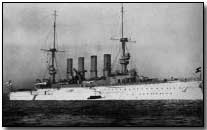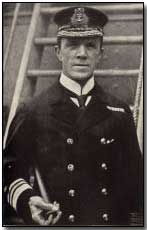Battles - The Battle of the Falkland Islands, 1914
 Fresh from his success at the Battle of Coronel, off the southern coast of Chile, where the Germans outgunned the
British, sinking British Admiral Cradock's flagship in the process,
Admiral Graf Maximilian von Spee's East Asiatic Squadron - whose primary target was
merchant and troop shipping in the South Atlantic - sped towards Port
Stanley, in the Falkland Islands. His intention was to raid the
British radio station and coaling depot there.
Fresh from his success at the Battle of Coronel, off the southern coast of Chile, where the Germans outgunned the
British, sinking British Admiral Cradock's flagship in the process,
Admiral Graf Maximilian von Spee's East Asiatic Squadron - whose primary target was
merchant and troop shipping in the South Atlantic - sped towards Port
Stanley, in the Falkland Islands. His intention was to raid the
British radio station and coaling depot there.
Unbeknownst to Spee however, a British squadron, including two fast, modern battle cruisers, Invincible and Inflexible, were at that same time coaling at Port Stanley, sent by First Sea Lord Admiral Fisher to reverse the British defeat at Coronel.
Each of the British battle cruisers were fitted with eight 12-inch guns, whereas Spee's Scharnhorst and Gneisenau each had 8.2-inch guns. In short, the British cruisers were significantly more powerful than Spee's - and Invincible and Inflexible were accompanied at Port Stanley by six other cruisers, all under the command of Vice Admiral Sturdee. These were the armoured cruisers Canarvon, Cornwall and Kent; two light cruisers, Bristol and Glasgow; and an old vessel, Canopus, presently grounded at Port Stanley and used as a form of make-shift fortress.
Spee began his attack on 8 December 1914, intending to subsequently refuel north at the Plate Estuary. Whilst aware of shipping in the area, he mistakenly assumed them to belong to the Japanese navy.
With his crew battle-weary and his ships out-gunned, the outcome was seemingly inevitable. Realising his danger too late - and having missed the golden opportunity to shell Sturdee's fleet while in port - Spee and his squadron dashed for the open sea, but at 10am were pursued by the British. Realising that he could not hope to outrun the fast British battle cruisers, Spee decided to bring about an engagement just after 1.20pm.
Despite initial success by Scharnhorst and Geneienau in striking the Invincible (commanded by Edward Bingham), and in then resuming a hasty escape, Sturdee managed to bring his powerful cruisers within extreme firing range some forty minutes later.
 Four
German cruisers were sunk, with Spee's flagship Scharnhorst sinking
rapidly first, followed by Gneisenau, Nurnberg and Leipzig.
Four
German cruisers were sunk, with Spee's flagship Scharnhorst sinking
rapidly first, followed by Gneisenau, Nurnberg and Leipzig.
Ten British sailors died during the battle, while none of the British ships were badly damaged. However 2,200 German sailors were killed or drowned in the encounter.
The only German ship to escape was the light cruiser Dresden, which roamed at large for a further three months before its captain surrendered off the Juan Fernandez Islands on 14 March. Evacuating his ship, he then scuttled it by detonating its main ammunition magazine.
As a consequence of the battle, German commerce raiding on the high seas was brought to an end. Just as significantly, Sturdee's success was taken as a tremendous morale booster by the British, entirely reversing the earlier setback at Coronel.
Click here to view a map of naval operations in 1914.
Photographs courtesy of Photos of the Great War website
A "Communication Trench" was a narrow trench constructed at an angle to a defensive trench to permit concealed access to the defensive trench.
- Did you know?
